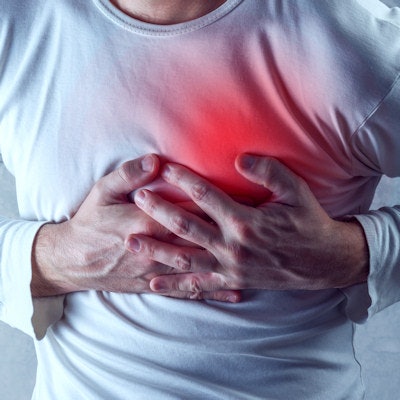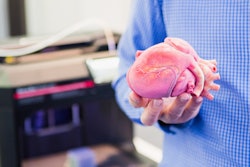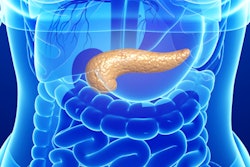
CT angiography (CTA) and CT stress myocardial perfusion imaging (MPI) can help predict heart attacks -- and offer the benefit of being less invasive than the traditional combination of coronary angiography and SPECT MPI stress tests, according to a study published online March 14 in Radiology.
The combination of coronary angiography and SPECT stress tests has been the standard for determining whether a patient is at risk for coronary artery disease (CAD), wrote a team led by Dr. Marcus Chen of the U.S. National Institutes of Health. However, invasive coronary angiography requires using a catheter inserted from a puncture point in the groin all the way up to the heart, which can cause complications in some patients. CTA and CT perfusion offer an alternative.
"The traditional approach with invasive catheterization requires that patients go to the hospital, get a catheter inserted into their leg and go in for the nuclear SPECT study on a different day," Chen said in a statement released by the RSNA. "Now with just one noninvasive test we can get ... important ... information about the coronary arteries."
Comparable performance?
Chen and colleagues evaluated the performance of combined CTA and CT stress myocardial perfusion imaging and compared it with the performance of invasive coronary angiography plus SPECT MPI in predicting future adverse cardiovascular events. They compared both approaches in 379 patients from 16 sites who were referred for invasive coronary angiography between November 2009 and July 2011. They assessed the techniques' ability to predict whether or not an event such as a heart attack, revascularization, arrhythmia, or hospitalization for chest pain or congestive heart failure could occur in the future.
Of the total patient cohort, 51 individuals, or 13.5%, experienced one or more of these types of events, with 49 revascularizations, five heart attacks, one cardiac death, nine hospitalizations for chest pain or congestive heart failure, and one arrhythmia.
CTA and CT stress MPI had a similar performance to invasive coronary angiography with SPECT MPI for predicting major adverse cardiac events at two years after the patients first presented, the researchers found. CT angiography and CT perfusion had a 94% negative rate for CAD versus an 82% positive rate; combined invasive coronary angiography and SPECT had a 93% negative rate for CAD versus a 77% positive rate.
"A purely noninvasive anatomic and physiologic assessment via CT angiography and myocardial perfusion is adequate to identify patients with a [major adverse cardiac event] at two-year follow-up in symptomatic patients suspected of having CAD," Chen and colleagues wrote.
Another benefit? CTA plus CT perfusion is more efficient: Median procedure time was 34 minutes, compared with 30 minutes for diagnostic invasive angiography plus 120 or more minutes for SPECT myocardial imaging, the group wrote.
An effective alternative
There are obstacles to the increased use of CTA and CT perfusion imaging instead of combined invasive coronary angiography and SPECT, the authors noted -- the main one is the lack of a reimbursement code for stress CT perfusion. However, incorporating the technique into clinical practice doesn't seem to be among the challenges: Physicians at 15 of the 16 centers included in the study had never performed the procedure before, but were able to learn it effectively, Chen said.
In any case, the research shows that there's an effective, less invasive alternative for predicting adverse cardiovascular events, said study author Dr. João A.C. Lima from Johns Hopkins Hospital and School of Medicine in the RSNA statement.
"The key finding of our study is that both techniques are equally effective in identifying which patients are going to have trouble down the road," he said. "The noninvasive option should be a preferred or at least strongly considered option by cardiologists and radiologists managing these patients because it is safer and less expensive, and patients like it better."
Study disclosures
The study was sponsored by Toshiba Medical Systems and supported by the Intramural Research Program of the National Heart, Lung, and Blood Institute of the National Institutes of Health.





















